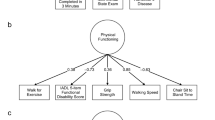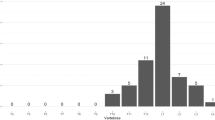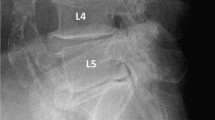Abstract
Little is known about the frequency or degree to which vertebral fractures cause pain and physical disability. The purpose of this investigation was to examine the advantages of risk analysis over other statistical techniques (e.g., correlation analysis) for quantifying relationships between vertebral fractures and outcomes such as pain and disability. Subjects who volunteered to participate in studies of osteoporosis were asked about pain and disability. The number and degree of vertebral deformities were assessed from radiographs. Strong associations were observed between the most severe vertebral deformities and the risk of high pain or disability scores, while weaker associations were observed for moderate deformities. There did not appear to be any association between vertebral deformity and risk of moderate levels of pain or disability. Because of the potential for bias in cross-sectional studies such as this, the magnitude of these findings must be considered tentative. We conclude that risk analysis is an appropriate method for quantifying the relationship of vertebral fractures with pain and disability, but that prospective studies are now needed.
Similar content being viewed by others
References
Ross PD, Wasnich RD, Vogel JM. Detection of pre-fracture spinal osteoporosis using bone mineral absorptiometry. J Bone Miner Res 1988; 3:1–11.
Melton LJ, III, Kan SH, Frye MA, Wahner HW, O'Fallon WM, Riggs BL. Epidemiology of vertebral fractures in women. Am J Epidemiol 1989; 129:1000–11.
Ettinger B, Block JE, Smith R, Cummings SR, Harris ST, Genant HK. An examination of the association between vertebral deformities, physical disabilities and psychosocial problems. Maturitas 1988; 10:283–96.
Leidig G, Minne HW, Sauer P et al. A study of complaints and their relation to vertebral destruction in patients with osteoporosis. Bone Miner 1990; 8:217–19.
Greenland S, Schlesselman JJ, Criqui MH. The fallacy of employing standardized regression coefficients and correlations as measures of effect. Am J Epidemiol 1986; 123:203–8.
Leigh JP. Assessing the importance of an independent variable in multiple regression: Is stepwise unwise? J Clin Epidemiol 1988; 41:669–77.
Ross PD, Heilbrun LK, Wasnich RD, Davis JW, Vogel JM. Methodologic issues in fracture risk assessment. J Bone Miner Res 1989; 4:649–56.
Finsen V. Osteoporosis and back pain among the elderly. Acta Med Scand 1988; 223:443–9.
Ross PD, Wasnich RD, Hagino R, MacLean CJ. A model for estimating the potential costs and savings of osteoporosis prevention strategies. Bone 1988; 9:337–47.
Lyritis GP, Mayasis B, Tsakalakos N et al. The natural history of the osteoporotic vertebral fracture. Clin Rheumatol 1989; 8(Suppl 2):66–9.
Nicoll EA. Fractures of the dorso-lumbar spine. J Bone Joint Surg [Br] 1949; 31B-3:376–94.
Baab OD. Fractures of the dorsal and lumbar spine. Clin Orthop 1966; 49:195–200.
Young MH. Long-term consequences of stable fractures of the thoracic and lumbar vertebral bodies. J Bone Joint Surg [Br] 1973; 55B-2:295–300.
Hazel WA, Jones RA, Morrey BF, Stauffer RN. Vertebral fractures without neurological deficit. A long-term follow-up study. J Bone Joint Surg [Am] 1988; 70-A:1319–21.
Rothman KJ. Modern epidemiology. Boston: Little, Brown 1986.
Ross PD, Davis JW, Wasnich RD, Vogel JM. A critical review of bone mass and the risk of fractures in osteoporosis. Calcif Tissue Int 1990; 46:149–61.
Ellis JD. Compression fractures of the vertebral bodies and other changes mistaken for them. J Bone Joint Surg 1944; 26:139–45.
Hurxthal LM. Measurement of anterior vertebral compressions and biconcave vertebrae. AJR 1968; 103:635–44.
Deguchi T, Inoue T, Kushida K, Sumi Y, Orimo H, Yamashita G. Computer assessment of vertebral deformity (Report 1). JBMM 1988; 6:21–8.
Gold DT, Lyles KW, Bales CW, Drezner MK. Teaching patients coping behaviors: An essential part of successful management of osteoporosis. J Bone Miner Res 1989; 4:799–801.
Author information
Authors and Affiliations
Rights and permissions
About this article
Cite this article
Ross, P.D., Ettinger, B., Davis, J.W. et al. Evaluation of adverse health outcomes associated with vertebral fractures. Osteoporosis Int 1, 134–140 (1991). https://doi.org/10.1007/BF01625442
Received:
Accepted:
Issue Date:
DOI: https://doi.org/10.1007/BF01625442




